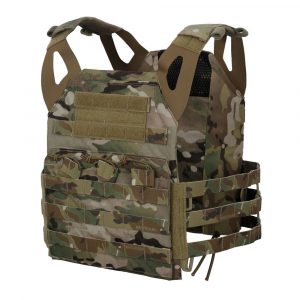
Ballistic plate carriers are the gold standard in providing protection from high powered weapons. They have been an essential piece of protective gear for law enforcement and the military for almost two decades, and the most common question we receive about plate carriers is how to set them up so we built this guide to help.
Find the Right Plate Carrier
Given how important plate carriers are, it makes sense that there are so many options to meet different needs. Depending on your job and mission, you might choose something lightweight and adjustable like this Crye Precision carrier, or something more heavy duty like this Condor plate carrier. You’ll need to consider how you’ll be using the carrier and what’s allowed in your unit when you’re choosing one.
 Fit
Fit
Having gear that fits properly is always important, but having improperly fitted plate carriers can be the difference between life and death.
Front and Back Panels
Your front and back panels are designed to protect your vital organs and need to be fitted properly over them. Start by measuring two fingers below your collarbone. This is where the top of your front panel should sit. Then, get a friend to help you fit the back panel to the same height.
Shoulder Straps
Once your front and back panels are set at the right height, you need to check your shoulder straps to make sure the panels are level. Once all the parts are in place, test out the fit by moving around. You should make sure everything feels comfortable and your movement and breathing are not restricted.
Plan for Your Mission
Different missions have different needs. Think about what you’ll be doing in your carrier. What kind of plates do you need? What gear do you need to bring? How are you going to move while wearing the carrier? All of this will determine what you need to carry and how to finalize your setup.
Gather and Organize Your Gear
Get everything you want to put on your carrier and lay it out in one place – now think hard about what you really need and what you can do without. Your plate carrier setup needs to strike a balance between having everything you need and not having so much that your movement will be restricted.
 Choose Your Gear Layout
Choose Your Gear Layout
Your gear will depend mostly on your mission, but a good rule of thumb is that your most valuable pieces of gear should be the most accessible ones. You should also keep anything you’ll need quickly near your dominant hand for easy access.
Front Panel
Most people put their ammo and magazines in their front panels since these are important items you’ll need to access quickly. The number and type of magazines you include will depend on what weapons you’re carrying and your mission. Just make sure you’re still able to lay and shoot in a prone position when all your magazines are in place.
Shoulder Straps
Keep your shoulder straps clean so that you have space to properly position your weapon. That being said, the shoulder strap on your non-shooting side is a great place to place your radio or other small communication device.
Side Panels
Your side panels should be reserved for your personal medical gear, like an IFAK and tourniquets. Put them on the same side as your non-shooting hand so you can reach them easily. Make sure you test out how accessible they are because you’re going to want to make sure you can reach these without any help.
Back Panel
Your back panel should be reserved for things you need, but that don’t have to be in immediate reach during the heat of battle, like your hydration pack. The back panel is also a good place for more magazines.
You can put your medic pouch on your back panel as long as you have your IFAK on the side. That way you know you can access your emergency medical gear yourself, but you have additional supplies that can be accessed by someone else.
Front Pouch
Most plate carriers allow for an optional front pouch, which is a good place for items like maps, tactical pens, notebooks, and fire starters. Customize this pouch to your mission needs and be sure not to overload it. Every ounce counts when you need to move quickly.
Testing the Plate Carrier Setup
Once you think you have your set up, test it out. Walk, run, jump, and move around while wearing your fully loaded plate carrier. Make sure your movements and breathing aren’t restricted and that you can easily reach everything on the plate carrier.
Now that you know how to set up a plate carrier, remember there’s always room for improvement. Your safety shouldn’t cause discomfort, so don’t be afraid to adjust and refine your plate carrier setup until you have it exactly the way you need it.





